BBC Earth newsletter
BBC Earth delivered direct to your inbox
Sign up to receive news, updates and exclusives from BBC Earth and related content from BBC Studios by email.
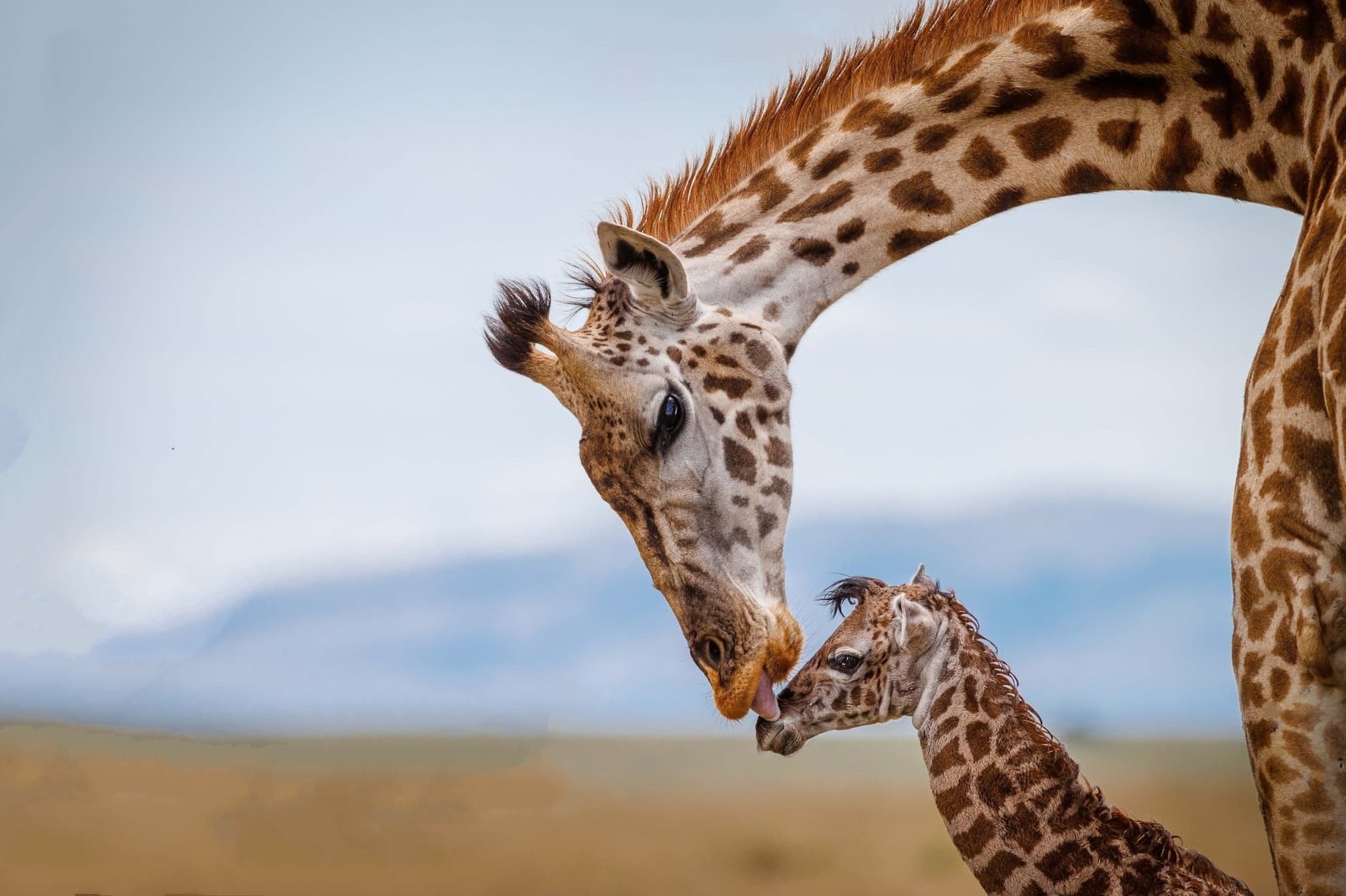
With their long napes and lanky legs, giraffes are literally head and shoulders above the rest – towering over the arid African savannahs, they are the tallest mammals roaming the Earth.
The spindly-legged, long-necked giants of the steppe have long fascinated scientists and explorers, with their unique looks and gentle manners. It’s a well-known fact that the giraffe’s height gives it access to some of the most succulent leaves in its habitat, but there’s lots more to discover about this African colossus: giraffes have a powerful heart, quick wits, a spectacular spotted coat, babies who hit the ground running, great sprinting abilities, and they even have a penchant for swimming.
Giraffes – whose only close relation is the okapi, an animal resembling a cross between a zebra and a giraffe – have long been thought of as one species, split up into nine smaller subspecies depending on subtle differences in spot patterns.1 This is how the International Union for the Conservation of Nature (IUCN) still groups giraffes, too.2
But since the 2000s, researchers have been able to use detailed DNA and genetic data to parse these dissimilarities more accurately. Results suggest there are various separate species of giraffe, but the jury is out on exactly how many: some experts think there are six species, while others believe there are eight, depending on how information is examined.3 Most scientists now think there are probably four – the northern giraffe, the southern giraffe, the Masai giraffe, and the reticulated giraffe.4 The business of classification can be a little complicated.
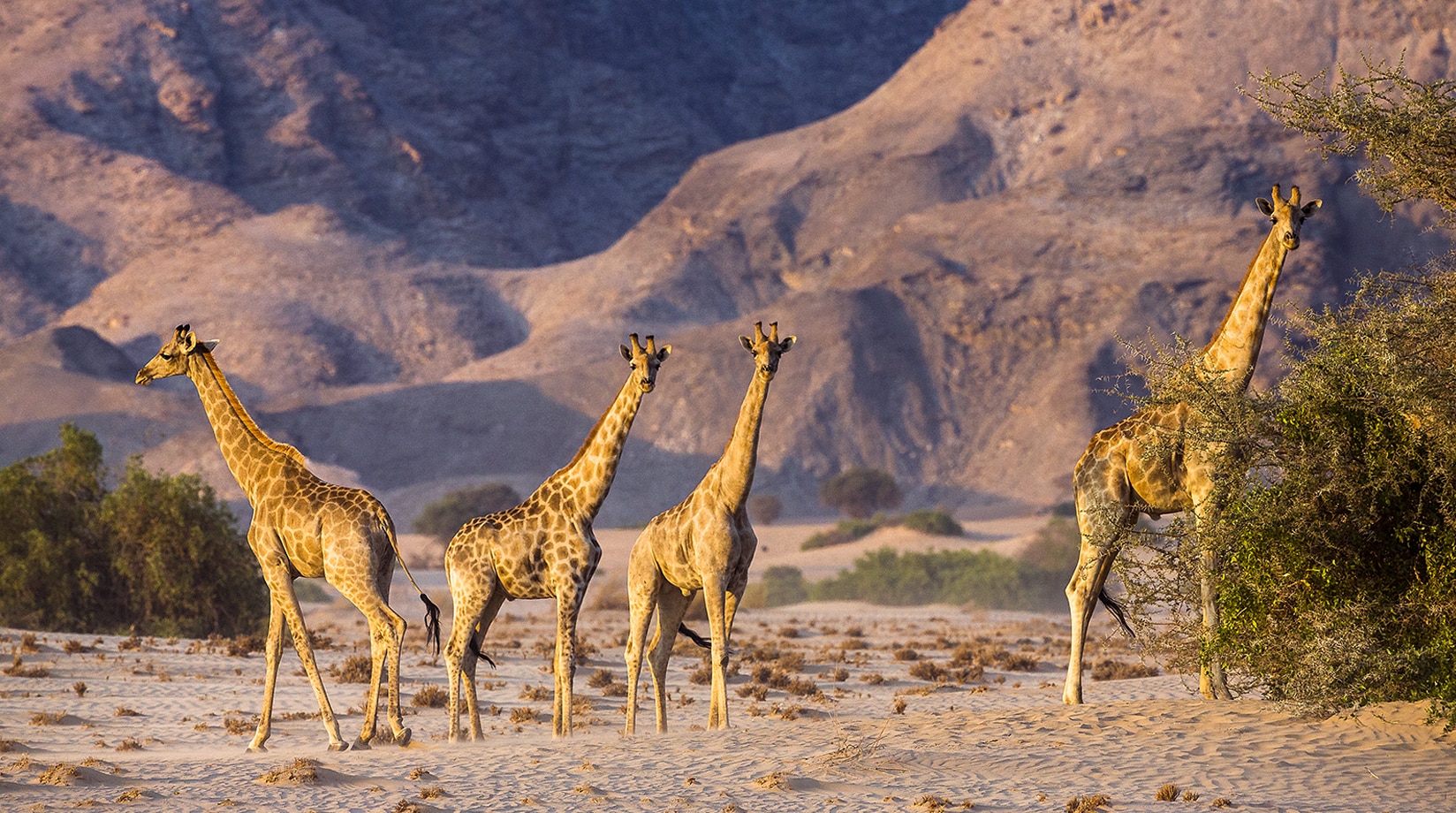
Giraffes are one of the most iconic and unique animals. What is not to love about them? They are a symbol for so many people in Africa and represent so much to the world. They change landscapes, are pollinators and seed dispersers, and act as sentinels by being the tallest land mammals in the world. They are simply stunning critters that we need to conserve before it is too late.”
Giraffes in the wild are only found in Africa. They are sparsely distributed across 21 countries, from Nigeria in the west, to Ethiopia in the east, and down to Namibia and South Africa – the latter being home to the most giraffes in the continent.5 Over the past 4,000 years, giraffes have disappeared from the north of Africa, including in Egypt and Morocco.6 Today, the remaining populations roam semi-desert areas, dry savannahs and open grasslands, grazing on a sparse number of trees, bushes, and shrubs for food.
About 70% of giraffe populations live in areas that aren’t protected by conservation efforts.7
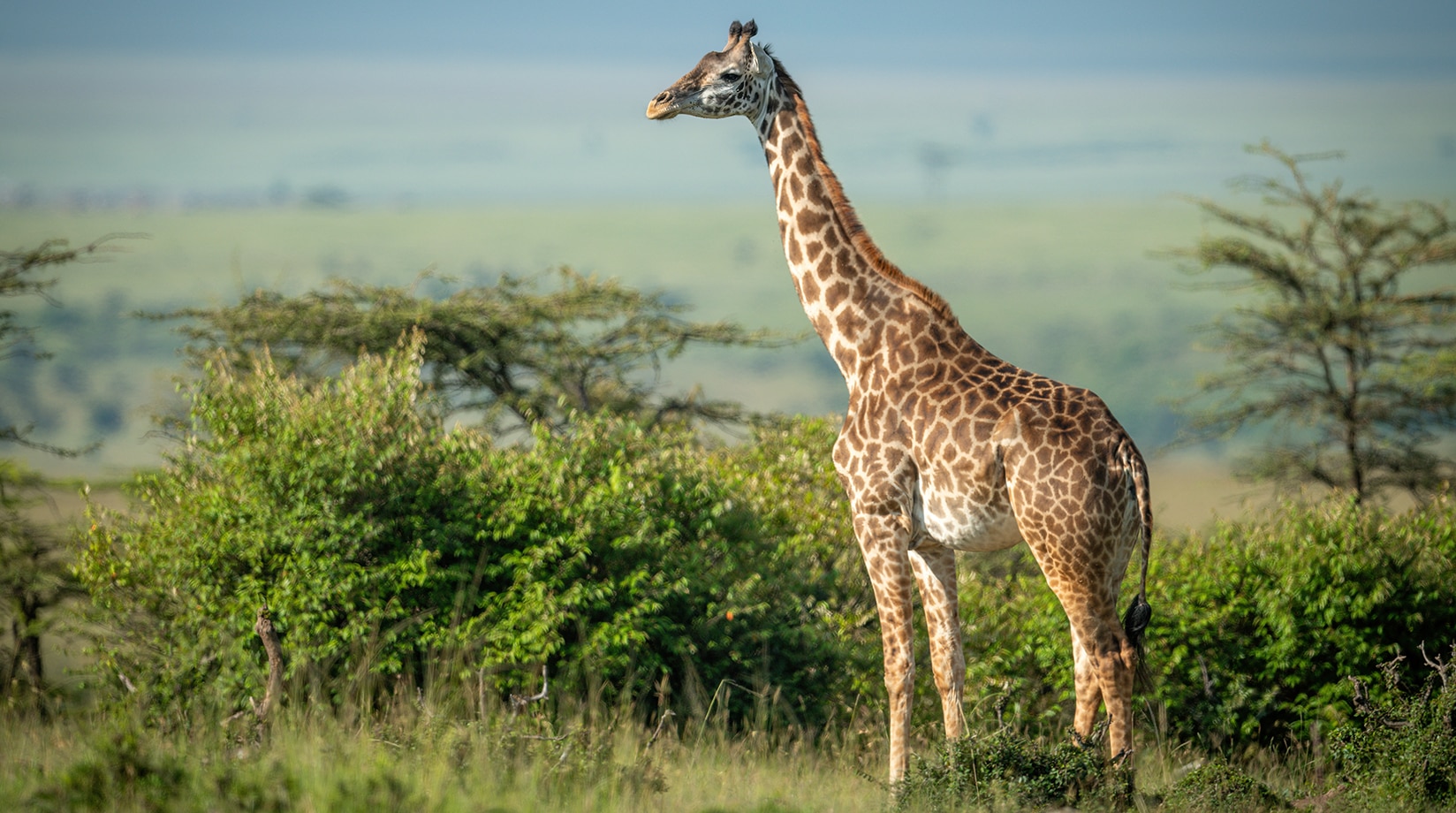
Their iconic spotted coat is one of the key features which make giraffes so recognisable, made up of a tan background with splashes of chestnut. So much so, that when giraffes were first discovered, taxonomists gave them the moniker Giraffa camelopardalis because they thought they looked like flute-legged camels marked like leopards.8
The markings are much like human fingerprints; every giraffe has a look unique to him or her.9 Different species and subspecies have slightly different markings: one Masai giraffe subspecies has really dark, jagged, leaf-like spots, while reticulated giraffes look like they’re covered in an orange-brown colour with a net of sharp white lines overlaid.10
This pattern is good camouflage for the beige, warm-coloured environments that giraffes inhabit.11 The blotches are also helpful for keeping giraffes cool in the arid heat of Africa, because the parts of their bodies with darker fur have extra tiny capillaries to release their warmth.
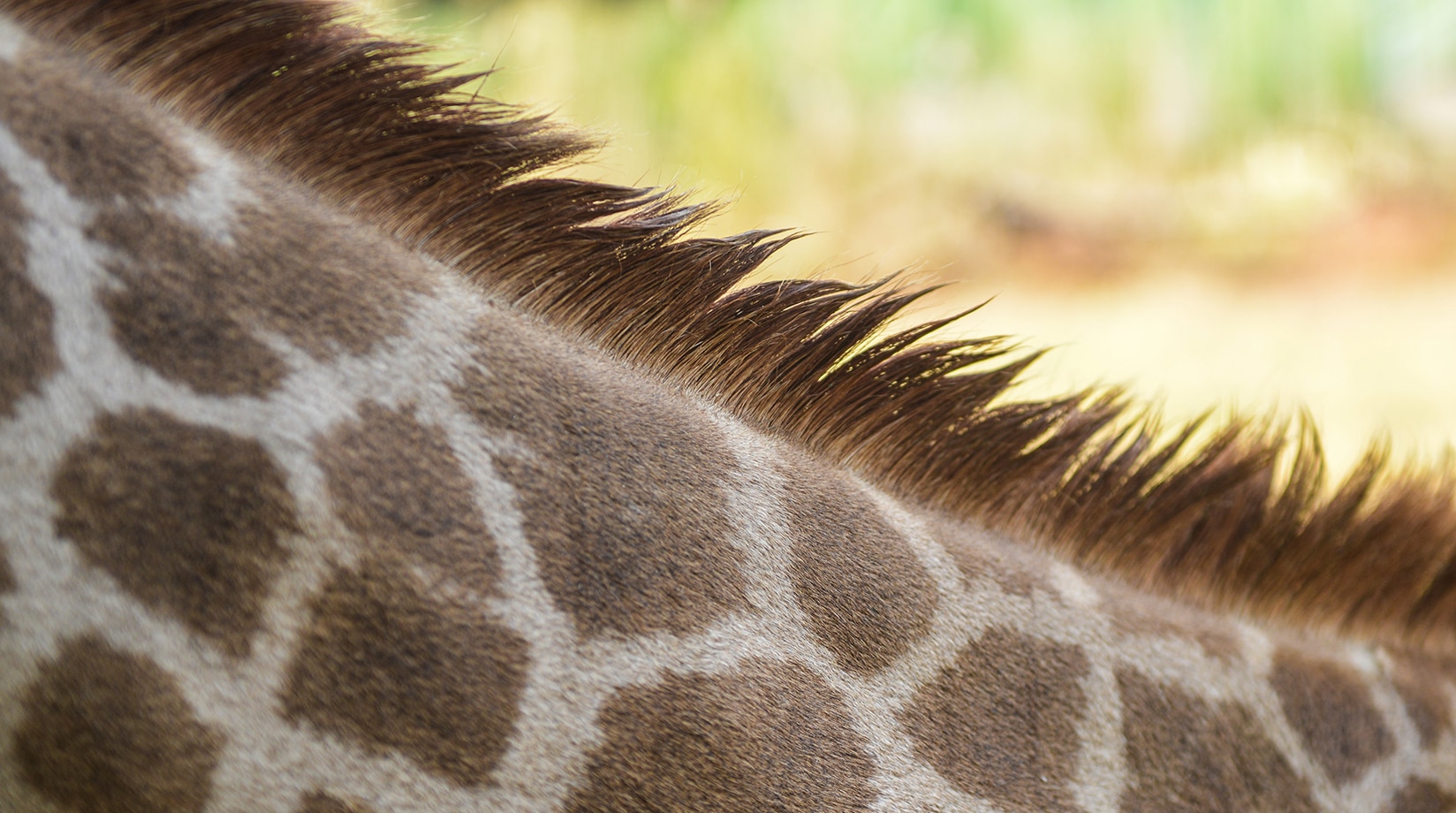
Giraffes are the tallest mammals walking the Earth today, growing up to 5.5m tall. The tallest giraffe ever recorded was George, a male Masai giraffe living at Chester Zoo in the UK.12 These giants owe their height to their spindly 1.8m-long legs and their prolonged nape, which measures an average of 1.8m.13 Whilst they’re smaller when they’re just born, it only takes about four years for giraffes to reach their full height.14
Towering over the vast, barren savannah comes with lots of perks: giraffes can reach luscious leaves at the top of trees which nobody else can get to, and their height gives them a helpful perspective when looking out for any threats or predators.15 Still, being so tall does make it hard to reach the ground with their mouths. In order to access rivers and ponds to drink water, giraffes have to open up their legs as if doing the splits, balancing precariously and becoming vulnerable to risks presented by the savannah.16
Male giraffes weigh up to 1,900kg, the weight of a car, and their tail can reach up to more than a metre in length, longer than any other mammal.17
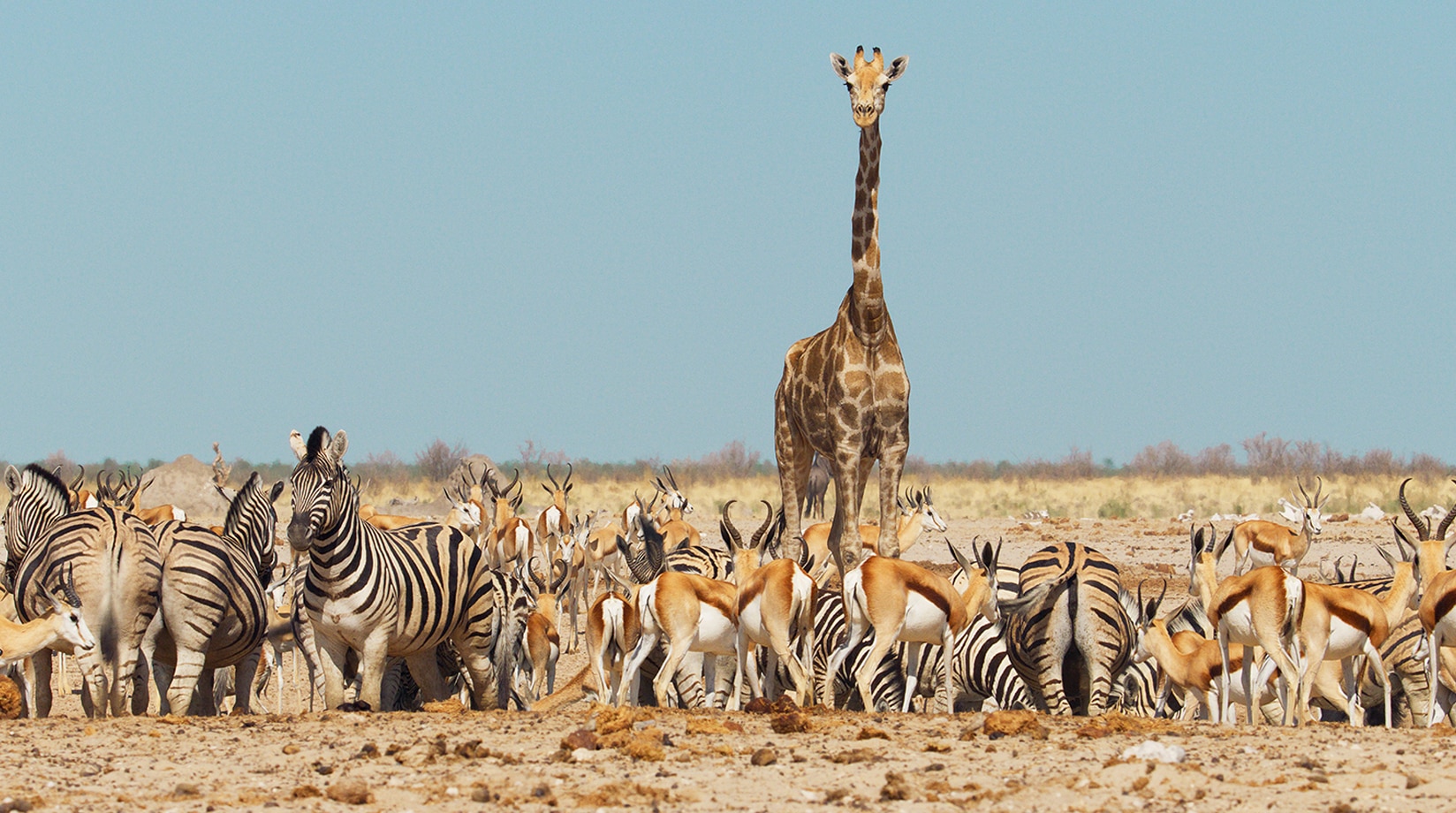
An adult giraffe has a neck of about 1.8m in length, which is longer than the whole body of an average human being.18 But the neck of a giraffe still only has seven vertebrae bones, just like us (and almost all other mammals) – they’re just really elongated vertebrae.
Having such a long neck comes in handy for reaching leaves at the top of trees, which is what giraffes most love to snack on. But some researchers think that male giraffes might have also evolved long, strong necks to gain an advantage when fighting off other males and showing what good mates they can be.19
The chunky bumps on top of a giraffe’s head are neither horns nor antlers: they’re called ossicones.20 These are hard knobs of cartilage which fuse into their skull and become protruding bones as the giraffe grows older. Both males and females have them, and they’re covered in skin and fluffy fur.21
Females sometimes use their ossicones to fend off predators and head-butt them away. Males, known as bulls, use them in duels with other giraffes, as they sometimes fight each other. They literally go head-to-head in a head-butting battle called ‘necking’. To protect their heads from the effects of fighting, some males grow lumps of calcium on their skulls, too.22
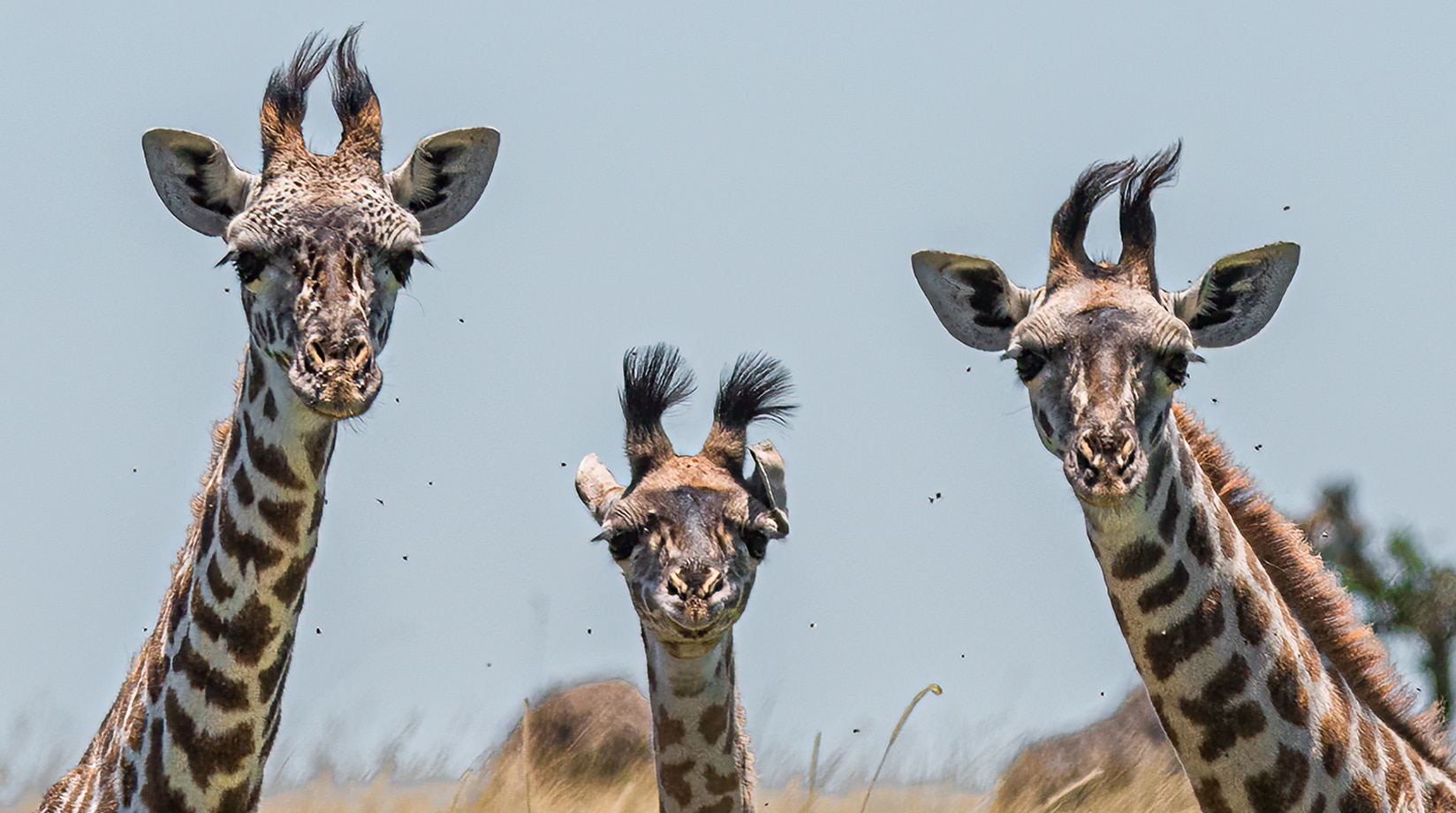
Giraffes truly are animals to look up to – because they spend most of their lives standing up. Once born, they literally hit the ground running: it only takes them about half an hour to be able to stand up and walk around.23
They can also rest and sleep while still standing up, especially out in the wild. But their sleep is not like a human’s deep sleep: giraffes usually only have a few quick two-minute naps every once in a while, and about 30 minutes of sleep at night, amounting to five and a half hours in a day. This is called shallow sleep: their eyes are half open, and their ears are twitching.24
Most of this sleeping time is spent standing up, but this can vary. An experiment on Angolan giraffes in the wild suggested that giraffes might take turns lying down, resting for entire hours while others in the herd stay vigilant.25 A different experiment on zoo-dwelling giraffes suggested that these giraffes crouch down to sleep only 4.7% of the time.26
Giraffes stand up so much that they even give birth whilst on all fours. Females can mate when they become five or six years old and until the age of about 24.27 Once they’ve mated successfully, they’re pregnant for 15 months.
Baby giraffes, called calves, are delivered from their mother while she’s standing up. The legs come out first, then the head, and then the calf falls straight onto the floor with a thud, which snaps their umbilical cord.28 They’re already about 2m tall and weigh around 100kg when they’re born and they will lie around for a couple of minutes before attempting to stand up.29
For the first week, the mother and baby hang out on their own before joining the rest of the herd. Then, the young giraffes are grouped with other young ones from their crew – like a small giraffe nursery. For the first year, baby giraffes still mainly drink their mother's milk and are slowly introduced to snacking on vegetation.30
Unfortunately, many of the features that make giraffes so good at eluding predators – being tall, strong, and being able to see them from afar – aren’t skills that juveniles have developed yet. Being a baby giraffe is hard, and more than half of all giraffe calves don’t make it past a year of age, as animals such as lions, hyenas, crocodiles and leopards ferociously hunt them.31
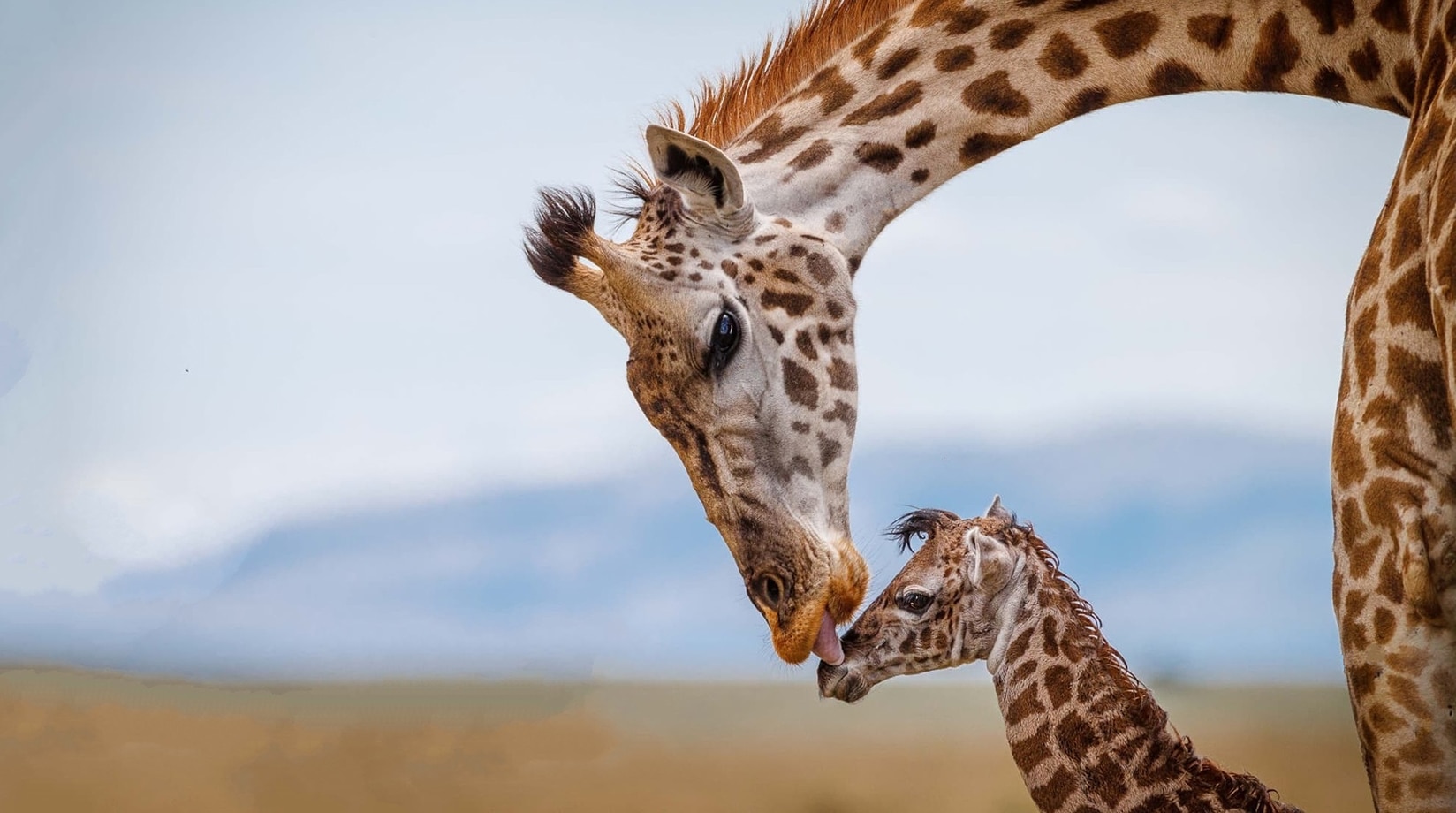
Despite giraffes being so big they could warrant having two hearts, this is actually a myth. Giraffes just have one large heart, which weighs about 11kg and can pump 60 litres of blood every minute.32
What makes giraffe hearts so exceptional is that they have thicker muscle on the left ventricle, so they can pump blood with enough power to send it shooting up the animal’s long neck.33 This powerful push means their blood pressure is twice that of humans. But giraffes don’t face the same threats from high blood pressure that humans would, thanks to special genes that help maintain their health.34
For example, a giraffe’s jugular veins – the ones in its neck – have highly elasticated walls which allow them to keep the blood flow going in the right direction at all times, even when a giraffe is bowing its head low.35
Giraffes are herbivores: they only eat plants. They spend most of their waking life eating, consuming more than 30kg of vegetation each day.36 They also get most of their hydration from the plants they’re gorging on, only stopping to drink a couple of times a week. Their height and long neck allow them the luxury of grazing on tall trees without any competition, reaching to gnaw on the juicy top leaves and buds of their favourite tree, the acacia.
Once they’ve secured a delicious green meal, giraffes chew on it, swallow it, and then regurgitate a ball of chewed vegetation called cud. Then they spit it out and chew it all over again to better digest it.37 Cows do the same, and this process is called rumination. It’s also why giraffes have four compartments in their stomachs.38
Giraffes spend a large amount of their time with their faces in treetops. This might also potentially help acacia trees with pollination as the giraffe moves acacia pollen from plant to plant as it wanders around.39
Although they don’t eat other animals, giraffes can sometimes be spotted gnawing away at bones.40 They don’t kill, but they do chew away at bits of carcasses because the calcium and phosphorus in bones supplement their leafy diet.41
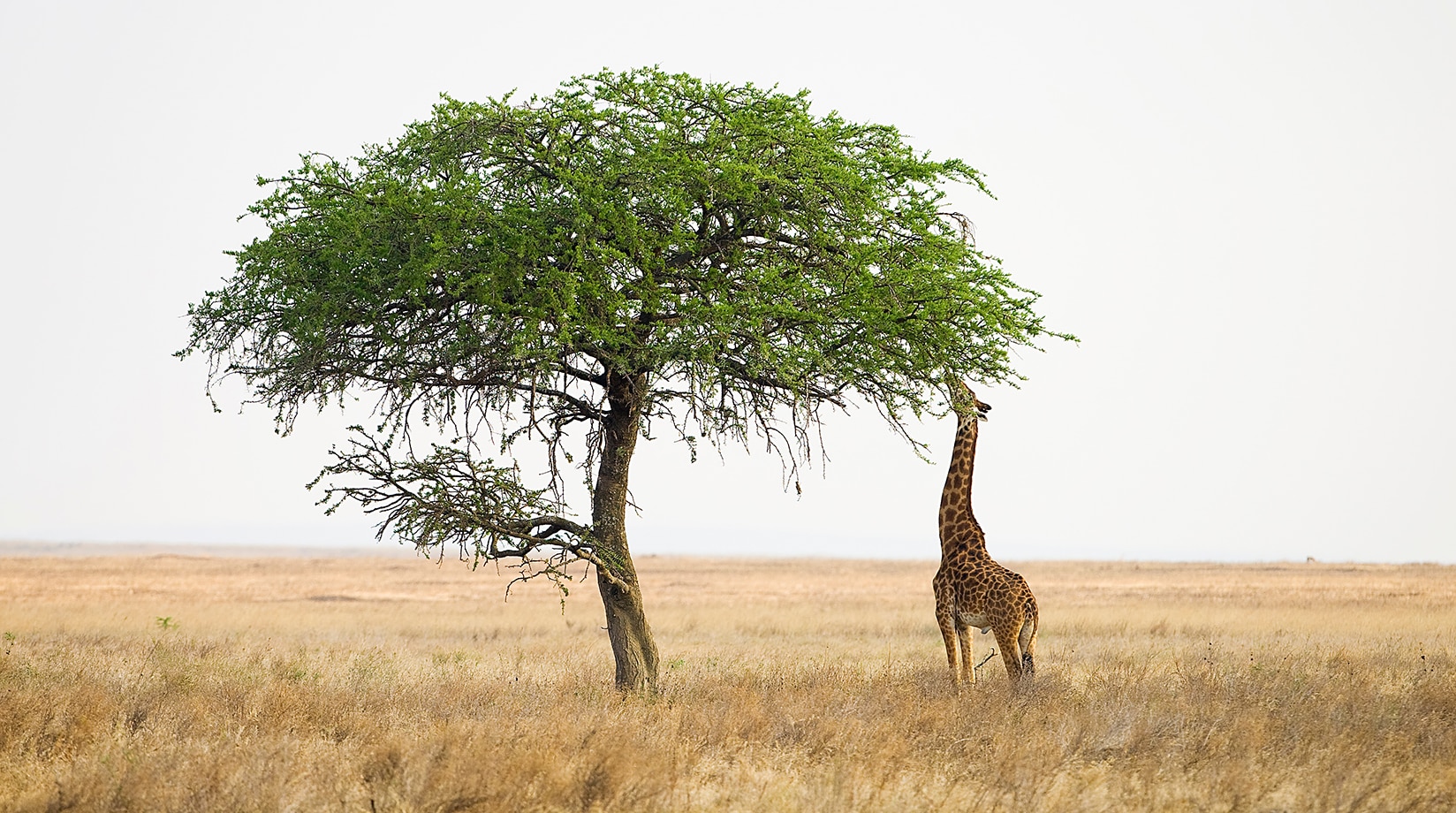
A giraffe’s tongue is crucial for treetop browsing, too.42 It is thick and resistant so it can clasp spiky, thorny bits of plant. It measures up to half a metre long and is prehensile, so it can reach, roll up and twist off tasty leaves and twigs with dexterity.43 It’s so long that giraffes can pick their nose with it. Plus, it’s tinted dark colours such as blue, purple or black, so it doesn’t get sunburned while hanging out of the giraffe’s mouth for most of the day.
Although their long, spindly legs might not look a good fit for sprinting, these hooved mammals are pretty good runners: they can sprint as fast as 60km/h and run at length at about 40km/h.44 Unlike horses, giraffes run by ‘pacing’, moving both right legs and then both left legs at the same time, like camels and elephants.45
There’s an ongoing debate about whether giraffes can swim, too. Hypothetically, being so large, tall and gangly would make it hard to swim effectively. But mathematical calculations suggest that an adult giraffe would indeed, theoretically, find itself able to float in 2.8m of water.46 This would be quite uncomfortable though, which might be why giraffes have probably never tried.
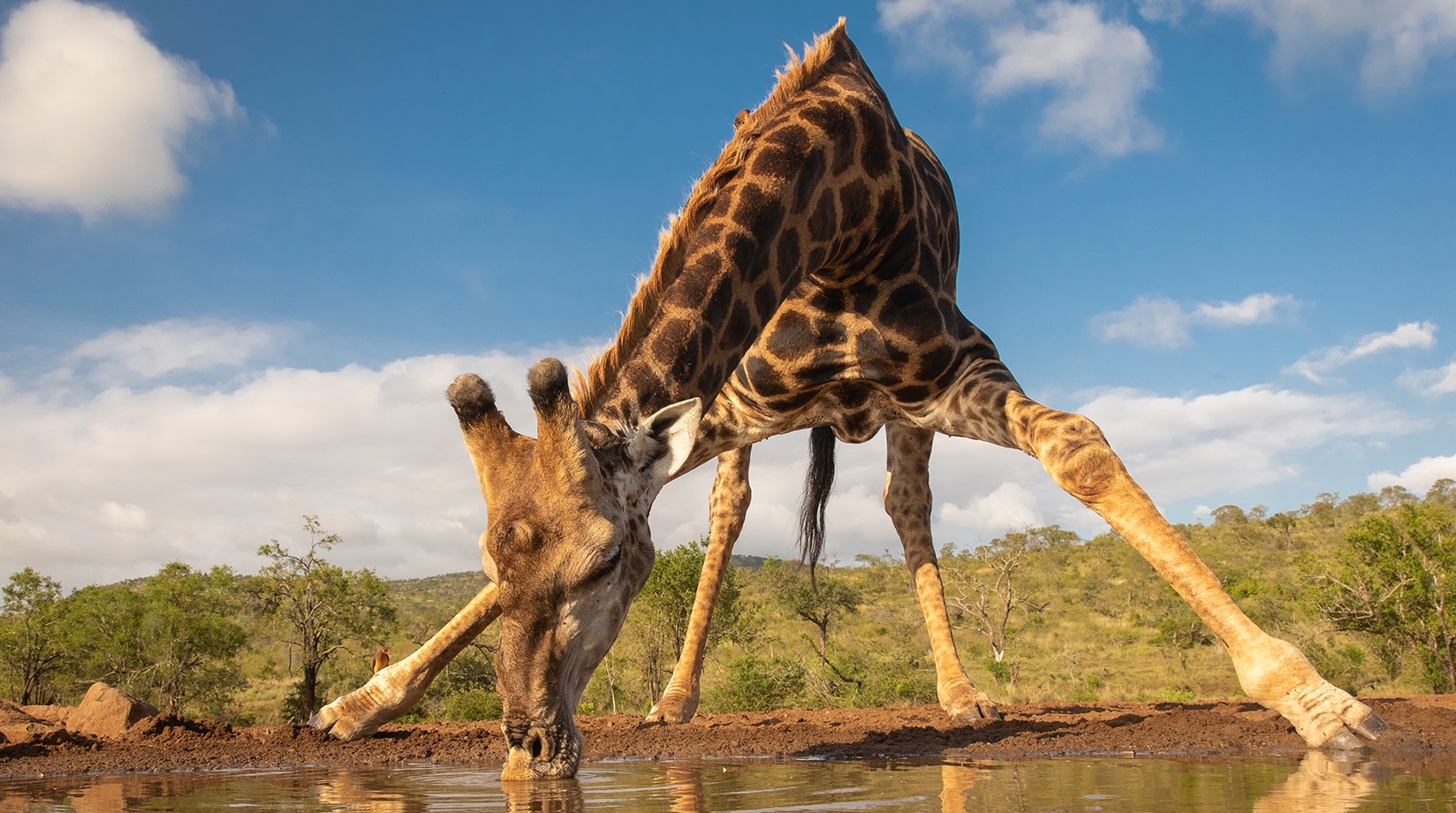
Giraffes have very small brains compared to their body size and compared to what’s typically expected of a mammal’s brain.47 Still, researchers are starting to think that brain size might not always indicate intelligence.48
And while giraffe intelligence hasn’t been widely researched, these long-necked animals could score highly when it comes to making informed decisions.49 Giraffes can discriminate between numerical quantities – which is basically animal counting – and they can use statistics to figure out where to find food.50
Giraffes have a complex society containing structures, such as herds, within structures, such as neighborhoods, built like Russian dolls. But they are quiet and only infrequently interact, so we have no real clue about how they create social bonds and how mothers and their adult daughters can recognize each other after spending years apart.”
Scientists initially thought that giraffes were socially aloof and didn’t form long-lasting bonds, but a growing body of research is starting to suggest otherwise.51
Giraffes freely roam around in groups of 10 to 20 called ‘towers’, and while herds grow and split and merge again, they have sophisticated relationships within the group, especially among females.52
Giraffe herds are often made up of up to three generations, and mothers and calves can stick together for up to 15 years.53 They like to hang out with other mother-children pairs in the group: mothers chip in to care for other children who aren’t their own and grieve if something happens to any of them.54 Childless female giraffes act as sort of nannies for the group.55 In fact, giraffes may also be subject to something called the ‘grandmother effect’.56 They spend more than 30% of their life in menopause, not being able to reproduce, and helping out with caring for the children of their relatives to ensure the success of their family and genes.
Giraffes also love to have lunch with their friends – they are often found eating with the same fellow giraffe.57
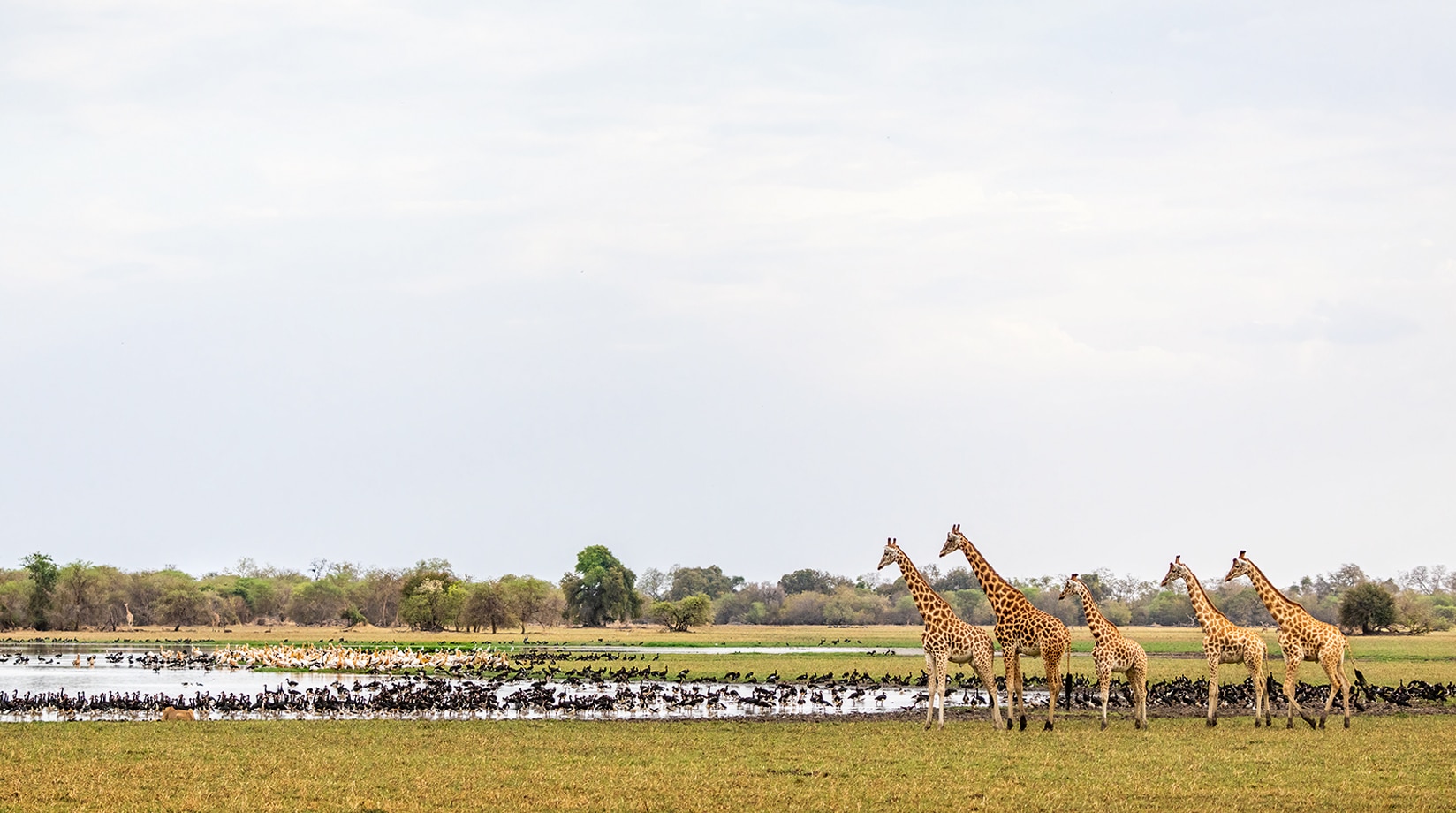
These gentle giants have been overlooked and have already become extinct in seven countries."
Towering over the savannah, giraffes don’t have many predators other than humans and lions.58 A giraffe will usually fend off any attack with head-butting and some formidable, not to mention lethal, karate-style kicks from any of its four legs.
Still, it’s not so much predators that threaten giraffe populations, but poaching and habitat destruction.59
Giraffes have already become extinct in seven countries in Africa, and their numbers are plummeting, in what has been described as a silent extinction.60 Their numbers have plunged about 40% in the last three decades, with only around 90,000 specimens probably left in the wild.61
Whether giraffes are seen as endangered or not still heavily relies on the debate about how many giraffe species there are in the first place. The IUCN – which groups all giraffes under one species, G. Camelopardalis – labels all giraffes as ‘Vulnerable’, and notes that one of the nine subspecies is ‘Least Concern’, one is ‘Near Threatened’, two are ‘Vulnerable’, one is ‘Endangered’ and two are ‘Critically Endangered.'62
Featured image © Vladimir Turkenich | Shutterstock
Fun fact image © prabhasnaps | Instagram
1. IUCN. 2019. “The IUCN Red List of Threatened Species.” IUCN Red List of Threatened Species. 2019. https://www.iucnredlist.org/species/9194/136266699
2. “Giraffe Conservation Status - Giraffe Conservation Foundation.” 2019. March 12, 2019. https://giraffeconservation.org/giraffe-conservation-status/#:~:text=Th…
3. Brown, David M, Rick A Brenneman, Klaus-Peter Koepfli, John P Pollinger, Borja Milá, Nicholas J Georgiadis, Edward E Louis, Gregory F Grether, David K Jacobs, and Robert K Wayne. 2007. “Extensive Population Genetic Structure in the Giraffe.” BMC Biology 5 (1): 57. https://doi.org/10.1186/1741-7007-5-; Petzold, Alice, and Alexandre Hassanin. 2020. “A Comparative Approach for Species Delimitation Based on Multiple Methods of Multi-Locus DNA Sequence Analysis: A Case Study of the Genus Giraffa (Mammalia, Cetartiodactyla).” Edited by Ulrich Joger. PLOS ONE 15 (2): e0217956. https://doi.org/10.1371/journal.pone.0217956
4. Fennessy, Julian, Tobias Bidon, Friederike Reuss, Vikas Kumar, Paul Elkan, Maria A. Nilsson, Melita Vamberger, Uwe Fritz, and Axel Janke. 2016. “Multi-Locus Analyses Reveal Four Giraffe Species instead of One.” Current Biology 26 (18): 2543–49. https://doi.org/10.1016/j.cub.2016.07.036
5. “New Maps Show Where Giraffes Live — Mostly Outside Protected Areas.” 2019. Mongabay Environmental News. October 22, 2019. https://news.mongabay.com/2019/10/new-maps-show-where-giraffes-live-mos….
6. Jirik, Kate. n.d. “LibGuides: Giraffes (Giraffa Spp.) Fact Sheet: Distribution & Habitat.” Ielc.libguides.com. https://ielc.libguides.com/sdzg/factsheets/giraffes/distribution.
7. O’connor, David, Jenna Stacy‐Dawes, Arthur Muneza, Julian Fennessy, Kathleen Gobush, Michael J. Chase, Michael B. Brown, et al. 2019. “Updated Geographic Range Maps for Giraffe, Giraffa Spp., throughout Sub‐Saharan Africa, and Implications of Changing Distributions for Conservation.” Mammal Review 49 (4): 285–99. https://doi.org/10.1111/mam.12165.
8. Mair, Victor , ed. 2022. Review of The Giraffe, a Supposedly Composite Creature with a Complicated Nomenclature. Language Log . July 24, 2022. https://languagelog.ldc.upenn.edu/nll/?p=55386.
9. Lee, Derek E., George G. Lohay, Douglas R. Cavener, and Monica L. Bond. 2022. “Using Spot Pattern Recognition to Examine Population Biology, Evolutionary Ecology, Sociality, and Movements of Giraffes: A 70-Year Retrospective.” Mammalian Biology, September. https://doi.org/10.1007/s42991-022-00261-3.
10. “Masai Giraffe Giraffa Tippelskirchi.” n.d. https://giraffeconservation.org/wp-content/uploads/2016/09/Spot-Pattern….
11. Jiwa, Val. 2021. “4 Functions of the Spotty Coat of Giraffes.” Kenya Wildlife Safaris. June 9, 2021. https://www.safari-center.com/4-functions-of-the-spotty-coat-of-giraffe….
12. “Tallest Giraffe Ever.” 1969. Guinness World Records. July 21, 1969. https://www.guinnessworldrecords.com/world-records/464584-tallest-giraf….
13. “Proprietary to Denver Zoological Foundation Reticulated Giraffe.” n.d. https://denverzoo.org/wp-content/uploads/2018/09/Reticulated-giraffe.pdf.
14. Herbison, Lory, and George W Frame. 2018. “Giraffe | Facts, Information, Habitat, & Lifespan.” In Encyclopædia Britannica. https://www.britannica.com/animal/giraffe.
15. Williams, Edgar. 2016. “Giraffe Stature and Neck Elongation: Vigilance as an Evolutionary Mechanism.” Biology 5 (3): 35. https://doi.org/10.3390/biology5030035.
16. Valeix, Marion, Hervé Fritz, Andrew J. Loveridge, Zeke Davidson, Jane E. Hunt, Felix Murindagomo, and David W. Macdonald. 2009. “Does the Risk of Encountering Lions Influence African Herbivore Behaviour at Waterholes?” Behavioral Ecology and Sociobiology 63 (10): 1483–94. https://doi.org/10.1007/s00265-009-0760-3.
17. Maisano, Sarah. 2019. “Giraffa Camelopardalis (Giraffe).” Animal Diversity Web. 2019. https://animaldiversity.org/accounts/Giraffa_camelopardalis/; Jirik, Kate. n.d. “LibGuides: Giraffes (Giraffa Spp.) Fact Sheet: Physical Characteristics.” Ielc.libguides.com. https://ielc.libguides.com/sdzg/factsheets/giraffes/characteristics.
18. WorldData. 2019. “Average Height of Men and Women Worldwide.” Worlddata.info. 2019. https://www.worlddata.info/average-bodyheight.php.
19. Simmons, Robert E., and Lue Scheepers. 1996. “Winning by a Neck: Sexual Selection in the Evolution of Giraffe.” The American Naturalist 148 (5): 771–86. https://doi.org/10.1086/285955.
20. “Headgear | AMNH.” 2024. American Museum of Natural History. 2024. https://www.amnh.org/exhibitions/extreme-mammals/extreme-bodies/headgear.
21. Spiiiage, C. A. 2008. “HORNS and OTHER BONY STRUCTURES of the SKULL of the GIRAFFE, and THEIR FUNCTIONAL SIGNIFICANCE.” African Journal of Ecology 6 (1): 53–61. https://doi.org/10.1111/j.1365-2028.1968.tb00900.x.
22. Mitchell, G., D. Roberts, S. van Sittert, and J. D. Skinner. 2013. “Growth Patterns and Masses of the Heads and Necks of Male and Female Giraffes.” Journal of Zoology 290 (1): 49–57. https://doi.org/10.1111/jzo.12013.
23. “Five Things You Probably Didn’t Know about Giraffe Births.” 2018. Monarto Safari Park. February 12, 2018. https://www.monartosafari.com.au/facts-giraffe-birth/.
24. Jirik, Kate. 2021. “LibGuides: Giraffes (Giraffa Spp.) Fact Sheet: Behavior & Ecology.” Ielc.libguides.com. 2021. https://ielc.libguides.com/sdzg/factsheets/giraffes/behavior.
25. Burger, Anna Lena, Julian Fennessy, Stephanie Fennessy, and Paul W. Dierkes. 2020. “Nightly Selection of Resting Sites and Group Behavior Reveal Antipredator Strategies in Giraffe.” Ecology and Evolution 10 (6): 2917–27. https://doi.org/10.1002/ece3.6106.
26. TOBLER, I., and B. SCHWIERIN. 1996. “Behavioural Sleep in the Giraffe ( Giraffa Camelopardalis ) in a Zoological Garden.” Journal of Sleep Research 5 (1): 21–32. https://doi.org/10.1046/j.1365-2869.1996.00010.x.
27. Jirik, Kate. 2021. “LibGuides: Giraffes (Giraffa Spp.) Fact Sheet: Reproduction & Development.” Ielc.libguides.com. 2021. https://ielc.libguides.com/sdzg/factsheets/giraffes/reproduction.
28. “Giraffe Birth at the Memphis Zoo.” n.d. Www.youtube.com. https://www.youtube.com/watch?v=1kZW8e79Bm0.
29. Jirik, Kate. 2021. “LibGuides: Giraffes (Giraffa Spp.) Fact Sheet: Reproduction & Development.” Ielc.libguides.com. 2021. https://ielc.libguides.com/sdzg/factsheets/giraffes/reproduction.
30. Jirik, Kate. 2021. “LibGuides: Giraffes (Giraffa Spp.) Fact Sheet: Reproduction & Development.” Ielc.libguides.com. 2021. https://ielc.libguides.com/sdzg/factsheets/giraffes/reproduction.
31. “Starting Life.” n.d. Giraffe Conservation Foundation. https://giraffeconservation.org/facts/starting-life/.
32. Natterson-Horowitz, Barbara, Basil M Baccouche, Jennifer Mary Head, Tejas Shivkumar, Mads Frost Bertelsen, Christian Aalkjær, Morten H Smerup, Olujimi A Ajijola, Joseph Hadaya, and Tobias Wang. 2021. “Did Giraffe Cardiovascular Evolution Solve the Problem of Heart Failure with Preserved Ejection Fraction?” Evolution, Medicine, and Public Health 9 (1): 248–55. https://doi.org/10.1093/emph/eoab016.
33. Aalkjær, Christian, and Tobias Wang. 2021. “The Remarkable Cardiovascular System of Giraffes.” Annual Review of Physiology 83 (February): 1–15. https://doi.org/10.1146/annurev-physiol-031620-094629.
34. Holmes, Bob. 2021. “Heads Up! The Cardiovascular Secrets of Giraffes.” Knowable Magazine, May. https://doi.org/10.1146/knowable-051821-2.
35. Mitchell, G., and J D Skinner. 1993. “HOW GIRAFFE ADAPT to THEIR EXTRAORDINARY SHAPE.” Transactions of the Royal Society of South Africa 48 (2): 207–18. https://doi.org/10.1080/00359199309520271.
36. “Giraffe | San Diego Zoo Animals & Plants.” n.d. Animals.sandiegozoo.org. https://animals.sandiegozoo.org/animals/giraffe#:~:text=Giraffes%20may%….
37. “Giraffe | San Diego Zoo Animals & Plants.” n.d. Animals.sandiegozoo.org. https://animals.sandiegozoo.org/animals/giraffe#:~:text=Giraffes%20may%….
38. Mitchell, Graham. 2021. “The Machinery of Digestion.” How Giraffes Work, August, 147–86. https://doi.org/10.1093/oso/9780197571194.003.0008.
39. Fleming, Patricia A, Sally Hofmeyr, Susan W Nicolson, and Johan. 2006. “Are Giraffes Pollinators or Flower Predators of Acacia Nigrescens in Kruger National Park, South Africa?” Journal of Tropical Ecology 22 (03): 247–53. https://doi.org/10.1017/s0266467405003123.
40. Hutson, Jarod M., Chrissina C. Burke, and Gary Haynes. 2013. “Osteophagia and Bone Modifications by Giraffe and Other Large Ungulates.” Journal of Archaeological Science 40 (12): 4139–49. https://doi.org/10.1016/j.jas.2013.06.004.
41. Bredin, I.P., J.D. Skinner, and G. Mitchell. 2008. “Can Osteophagia Provide Giraffes with Phosphorus and Calcium?” Onderstepoort J Vet Res 75 (1). https://doi.org/10.4102/ojvr.v75i1.82.
42. Mitchell, Graham. 2021. “The World of Browsers.” How Giraffes Work, August, 121–46. https://doi.org/10.1093/oso/9780197571194.003.0007.
43. Emura, Shoichi, Toshihiko Okumura, and Huayue Chen. 2013. “Morphology of the Lingual Papillae in the Giraffe.” Okajimas Folia Anatomica Japonica 89 (4): 99–103. https://doi.org/10.2535/ofaj.89.99; Fernandez, Loraine Tarou, Meredith J. Bashaw, Richard L. Sartor, Nichole R. Bouwens, and Todd S. Maki. 2008. “Tongue Twisters: Feeding Enrichment to Reduce Oral Stereotypy in Giraffe.” Zoo Biology 27 (3): 200–212. https://doi.org/10.1002/zoo.20180.
44. Mitchell, Graham. 2021. “Exercise in Giraffes.” Oxford University Press EBooks, August, 292–315. https://doi.org/10.1093/oso/9780197571194.003.0013.
45. “Pace.” n.d. Vanat.ahc.umn.edu. Accessed July 2, 2024. https://vanat.ahc.umn.edu/gaits/pace.html.
46. Henderson, Donald M., and Darren Naish. 2010. “Predicting the Buoyancy, Equilibrium and Potential Swimming Ability of Giraffes by Computational Analysis.” Journal of Theoretical Biology 265 (2): 151–59. https://doi.org/10.1016/j.jtbi.2010.04.007.
47. Graïc, Jean-Marie, Antonella Peruffo, Cristina Ballarin, and Bruno Cozzi. 2017. “The Brain of the Giraffe (Giraffa Camelopardalis ): Surface Configuration, Encephalization Quotient, and Analysis of the Existing Literature.” The Anatomical Record 300 (8): 1502–11. https://doi.org/10.1002/ar.23593.
48. Font, Enrique, Roberto García-Roa, Daniel Pincheira-Donoso, and Pau Carazo. 2019. “Rethinking the Effects of Body Size on the Study of Brain Size Evolution.” Brain, Behavior and Evolution 93 (4): 1–14. https://doi.org/10.1159/000501161.
49. Howard, Scarlett. 2023. “Research Shows Giraffes Can Use Statistical Reasoning. They’re the First Animal with a Relatively Small Brain Known to Do This.” The Conversation. May 4, 2023. https://theconversation.com/research-shows-giraffes-can-use-statistical….
50. Caicoya, Alvaro L., Montserrat Colell, Ruben Holland, Conrad Ensenyat, and Federica Amici. 2020. “Giraffes Go for More: A Quantity Discrimination Study in Giraffes (Giraffa Camelopardalis).” Animal Cognition, October. https://doi.org/10.1007/s10071-020-01442-8; Caicoya, Alvaro L, Montserrat Colell, and Federica Amici. 2023. “Giraffes Make Decisions Based on Statistical Information.” Scientific Reports 13 (1): 5558–58. https://doi.org/10.1038/s41598-023-32615-3.
51. Muller, Zoe, and Stephen Harris. 2021. “A Review of the Social Behaviour of the Giraffe Giraffa Camelopardalis: A Misunderstood but Socially Complex Species.” Mammal Review 52 (1). https://doi.org/10.1111/mam.12268.
52. Carter, Kerryn D., Jennifer M. Seddon, Celine H. Frère, John K. Carter, and Anne W. Goldizen. 2013. “Fission–Fusion Dynamics in Wild Giraffes May Be Driven by Kinship, Spatial Overlap and Individual Social Preferences.” Animal Behaviour 85 (2): 385–94. https://doi.org/10.1016/j.anbehav.2012.11.011.
53. Bercovitch, Fred B., and Philip S.M. Berry. 2010. “Ecological Determinants of Herd Size in the Thornicroft’s Giraffe of Zambia.” African Journal of Ecology 48 (4): 962–71. https://doi.org/10.1111/j.1365-2028.2009.01198.x.
54. Bashaw, Meredith J., Mollie A. Bloomsmith, Terry L. Maple, and Fred B. Bercovitch. 2007. “The Structure of Social Relationships among Captive Female Giraffe (Giraffa Camelopardalis).” Journal of Comparative Psychology 121 (1): 46–53. https://doi.org/10.1037/0735-7036.121.1.46; Strauss, Megan K. L., and Zoe Muller. 2012. “Giraffe Mothers in East Africa Linger for Days near the Remains of Their Dead Calves.” African Journal of Ecology 51 (3): 506–9. https://doi.org/10.1111/aje.12040.
55. Muller, Z., I. C. Cuthill, and S. Harris. 2018. “Group Sizes of Giraffes in Kenya: The Influence of Habitat, Predation and the Age and Sex of Individuals.” Journal of Zoology 306 (2): 77–87. https://doi.org/10.1111/jzo.12571.
56. Blell, Mwenza. 2017. “Grandmother Hypothesis, Grandmother Effect, and Residence Patterns.” The International Encyclopedia of Anthropology, September, 1–5. https://doi.org/10.1002/9781118924396.wbiea2162.
57. Muller, Zoe, Mauricio Cantor, Innes C. Cuthill, and Stephen Harris. 2019. “Corrigendum to ‘Giraffe Social Preferences Are Context Dependent’ [Animal Behaviour 146 (2018) 37–49].” Animal Behaviour 150 (April): 175. https://doi.org/10.1016/j.anbehav.2019.02.013.
58. Bertelsen, Mads F. 2015. “Giraffidae.” Fowler’s Zoo and Wild Animal Medicine, Volume 8 8: 602–10. https://doi.org/10.1016/B978-1-4557-7397-8.00061-X.
59. Funnell, Nick. 2016. “How the Giraffe Was Almost Forgotten.” Bbcearth.com. 2016. https://www.bbcearth.com/news/how-the-giraffe-was-almost-forgotten.
60. BBC News. 2016. “Giraffes Facing ‘Silent Extinction’ as Population Plunges,” December 8, 2016, sec. Science & Environment. https://www.bbc.com/news/science-environment-38240760.
61. O’connor, David, Jenna Stacy‐Dawes, Arthur Muneza, Julian Fennessy, Kathleen Gobush, Michael J. Chase, Michael B. Brown, et al. 2019. “Updated Geographic Range Maps for Giraffe, Giraffa Spp., throughout Sub‐Saharan Africa, and Implications of Changing Distributions for Conservation.” Mammal Review 49 (4): 285–99. https://doi.org/10.1111/mam.12165.
62. GCF. 2019. “IUCN Red List Update - Giraffe Conservation Foundation.” Giraffe Conservation Foundation. March 18, 2019. https://giraffeconservation.org/2018/11/14/giraffe-subspecies-update/.
With their long napes and lanky legs, giraffes are literally head and shoulders above the rest – towering over the arid African savannahs, they are the tallest mammals roaming the Earth.
The spindly-legged, long-necked giants of the steppe have long fascinated scientists and explorers, with their unique looks and gentle manners. It’s a well-known fact that the giraffe’s height gives it access to some of the most succulent leaves in its habitat, but there’s lots more to discover about this African colossus: giraffes have a powerful heart, quick wits, a spectacular spotted coat, babies who hit the ground running, great sprinting abilities, and they even have a penchant for swimming.
Calf
Tower; Herd; Journey when walking
Herbivore; giraffes love acacia leaves
Lions; Hyenas; Leopards
From 20 to 28 years of age
Up to 5.5m tall, that’s almost three times Michael Jordan
Up to 1,900kg
East, middle, west Africa; South Africa
Around 68,000 adults, according to IUCN
The overall species of Giraffa camelopardalis is classified as ‘Vulnerable’
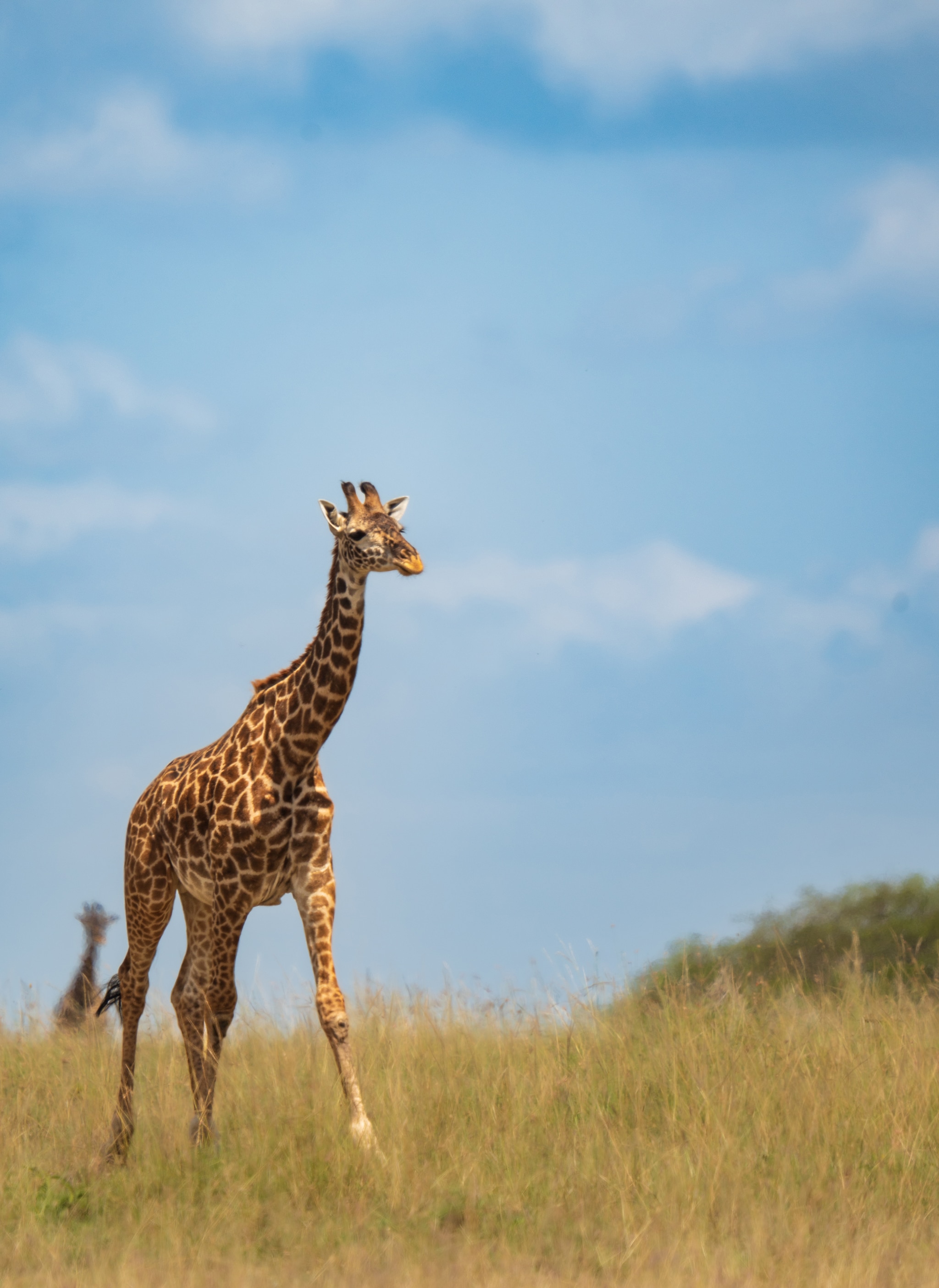
Giraffes truly are animals to look up to – because they spend most of their lives standing up. They stand up so much that they even give birth whilst on all fours.
Giraffes – whose only close relation is the okapi, an animal resembling a cross between a zebra and a giraffe – have long been thought of as one species, split up into nine smaller subspecies depending on subtle differences in spot patterns.1 This is how the International Union for the Conservation of Nature (IUCN) still groups giraffes, too.2
But since the 2000s, researchers have been able to use detailed DNA and genetic data to parse these dissimilarities more accurately. Results suggest there are various separate species of giraffe, but the jury is out on exactly how many: some experts think there are six species, while others believe there are eight, depending on how information is examined.3 Most scientists now think there are probably four – the northern giraffe, the southern giraffe, the Masai giraffe, and the reticulated giraffe.4 The business of classification can be a little complicated.

Giraffes are one of the most iconic and unique animals. What is not to love about them? They are a symbol for so many people in Africa and represent so much to the world. They change landscapes, are pollinators and seed dispersers, and act as sentinels by being the tallest land mammals in the world. They are simply stunning critters that we need to conserve before it is too late.”
Giraffes in the wild are only found in Africa. They are sparsely distributed across 21 countries, from Nigeria in the west, to Ethiopia in the east, and down to Namibia and South Africa – the latter being home to the most giraffes in the continent.5 Over the past 4,000 years, giraffes have disappeared from the north of Africa, including in Egypt and Morocco.6 Today, the remaining populations roam semi-desert areas, dry savannahs and open grasslands, grazing on a sparse number of trees, bushes, and shrubs for food.
About 70% of giraffe populations live in areas that aren’t protected by conservation efforts.7

Their iconic spotted coat is one of the key features which make giraffes so recognisable, made up of a tan background with splashes of chestnut. So much so, that when giraffes were first discovered, taxonomists gave them the moniker Giraffa camelopardalis because they thought they looked like flute-legged camels marked like leopards.8
The markings are much like human fingerprints; every giraffe has a look unique to him or her.9 Different species and subspecies have slightly different markings: one Masai giraffe subspecies has really dark, jagged, leaf-like spots, while reticulated giraffes look like they’re covered in an orange-brown colour with a net of sharp white lines overlaid.10
This pattern is good camouflage for the beige, warm-coloured environments that giraffes inhabit.11 The blotches are also helpful for keeping giraffes cool in the arid heat of Africa, because the parts of their bodies with darker fur have extra tiny capillaries to release their warmth.

Giraffes are the tallest mammals walking the Earth today, growing up to 5.5m tall. The tallest giraffe ever recorded was George, a male Masai giraffe living at Chester Zoo in the UK.12 These giants owe their height to their spindly 1.8m-long legs and their prolonged nape, which measures an average of 1.8m.13 Whilst they’re smaller when they’re just born, it only takes about four years for giraffes to reach their full height.14
Towering over the vast, barren savannah comes with lots of perks: giraffes can reach luscious leaves at the top of trees which nobody else can get to, and their height gives them a helpful perspective when looking out for any threats or predators.15 Still, being so tall does make it hard to reach the ground with their mouths. In order to access rivers and ponds to drink water, giraffes have to open up their legs as if doing the splits, balancing precariously and becoming vulnerable to risks presented by the savannah.16
Male giraffes weigh up to 1,900kg, the weight of a car, and their tail can reach up to more than a metre in length, longer than any other mammal.17

An adult giraffe has a neck of about 1.8m in length, which is longer than the whole body of an average human being.18 But the neck of a giraffe still only has seven vertebrae bones, just like us (and almost all other mammals) – they’re just really elongated vertebrae.
Having such a long neck comes in handy for reaching leaves at the top of trees, which is what giraffes most love to snack on. But some researchers think that male giraffes might have also evolved long, strong necks to gain an advantage when fighting off other males and showing what good mates they can be.19
The chunky bumps on top of a giraffe’s head are neither horns nor antlers: they’re called ossicones.20 These are hard knobs of cartilage which fuse into their skull and become protruding bones as the giraffe grows older. Both males and females have them, and they’re covered in skin and fluffy fur.21
Females sometimes use their ossicones to fend off predators and head-butt them away. Males, known as bulls, use them in duels with other giraffes, as they sometimes fight each other. They literally go head-to-head in a head-butting battle called ‘necking’. To protect their heads from the effects of fighting, some males grow lumps of calcium on their skulls, too.22

Giraffes truly are animals to look up to – because they spend most of their lives standing up. Once born, they literally hit the ground running: it only takes them about half an hour to be able to stand up and walk around.23
They can also rest and sleep while still standing up, especially out in the wild. But their sleep is not like a human’s deep sleep: giraffes usually only have a few quick two-minute naps every once in a while, and about 30 minutes of sleep at night, amounting to five and a half hours in a day. This is called shallow sleep: their eyes are half open, and their ears are twitching.24
Most of this sleeping time is spent standing up, but this can vary. An experiment on Angolan giraffes in the wild suggested that giraffes might take turns lying down, resting for entire hours while others in the herd stay vigilant.25 A different experiment on zoo-dwelling giraffes suggested that these giraffes crouch down to sleep only 4.7% of the time.26
Giraffes stand up so much that they even give birth whilst on all fours. Females can mate when they become five or six years old and until the age of about 24.27 Once they’ve mated successfully, they’re pregnant for 15 months.
Baby giraffes, called calves, are delivered from their mother while she’s standing up. The legs come out first, then the head, and then the calf falls straight onto the floor with a thud, which snaps their umbilical cord.28 They’re already about 2m tall and weigh around 100kg when they’re born and they will lie around for a couple of minutes before attempting to stand up.29
For the first week, the mother and baby hang out on their own before joining the rest of the herd. Then, the young giraffes are grouped with other young ones from their crew – like a small giraffe nursery. For the first year, baby giraffes still mainly drink their mother's milk and are slowly introduced to snacking on vegetation.30
Unfortunately, many of the features that make giraffes so good at eluding predators – being tall, strong, and being able to see them from afar – aren’t skills that juveniles have developed yet. Being a baby giraffe is hard, and more than half of all giraffe calves don’t make it past a year of age, as animals such as lions, hyenas, crocodiles and leopards ferociously hunt them.31

Despite giraffes being so big they could warrant having two hearts, this is actually a myth. Giraffes just have one large heart, which weighs about 11kg and can pump 60 litres of blood every minute.32
What makes giraffe hearts so exceptional is that they have thicker muscle on the left ventricle, so they can pump blood with enough power to send it shooting up the animal’s long neck.33 This powerful push means their blood pressure is twice that of humans. But giraffes don’t face the same threats from high blood pressure that humans would, thanks to special genes that help maintain their health.34
For example, a giraffe’s jugular veins – the ones in its neck – have highly elasticated walls which allow them to keep the blood flow going in the right direction at all times, even when a giraffe is bowing its head low.35
Giraffes are herbivores: they only eat plants. They spend most of their waking life eating, consuming more than 30kg of vegetation each day.36 They also get most of their hydration from the plants they’re gorging on, only stopping to drink a couple of times a week. Their height and long neck allow them the luxury of grazing on tall trees without any competition, reaching to gnaw on the juicy top leaves and buds of their favourite tree, the acacia.
Once they’ve secured a delicious green meal, giraffes chew on it, swallow it, and then regurgitate a ball of chewed vegetation called cud. Then they spit it out and chew it all over again to better digest it.37 Cows do the same, and this process is called rumination. It’s also why giraffes have four compartments in their stomachs.38
Giraffes spend a large amount of their time with their faces in treetops. This might also potentially help acacia trees with pollination as the giraffe moves acacia pollen from plant to plant as it wanders around.39
Although they don’t eat other animals, giraffes can sometimes be spotted gnawing away at bones.40 They don’t kill, but they do chew away at bits of carcasses because the calcium and phosphorus in bones supplement their leafy diet.41

A giraffe’s tongue is crucial for treetop browsing, too.42 It is thick and resistant so it can clasp spiky, thorny bits of plant. It measures up to half a metre long and is prehensile, so it can reach, roll up and twist off tasty leaves and twigs with dexterity.43 It’s so long that giraffes can pick their nose with it. Plus, it’s tinted dark colours such as blue, purple or black, so it doesn’t get sunburned while hanging out of the giraffe’s mouth for most of the day.
Although their long, spindly legs might not look a good fit for sprinting, these hooved mammals are pretty good runners: they can sprint as fast as 60km/h and run at length at about 40km/h.44 Unlike horses, giraffes run by ‘pacing’, moving both right legs and then both left legs at the same time, like camels and elephants.45
There’s an ongoing debate about whether giraffes can swim, too. Hypothetically, being so large, tall and gangly would make it hard to swim effectively. But mathematical calculations suggest that an adult giraffe would indeed, theoretically, find itself able to float in 2.8m of water.46 This would be quite uncomfortable though, which might be why giraffes have probably never tried.

Giraffes have very small brains compared to their body size and compared to what’s typically expected of a mammal’s brain.47 Still, researchers are starting to think that brain size might not always indicate intelligence.48
And while giraffe intelligence hasn’t been widely researched, these long-necked animals could score highly when it comes to making informed decisions.49 Giraffes can discriminate between numerical quantities – which is basically animal counting – and they can use statistics to figure out where to find food.50
Giraffes have a complex society containing structures, such as herds, within structures, such as neighborhoods, built like Russian dolls. But they are quiet and only infrequently interact, so we have no real clue about how they create social bonds and how mothers and their adult daughters can recognize each other after spending years apart.”
Scientists initially thought that giraffes were socially aloof and didn’t form long-lasting bonds, but a growing body of research is starting to suggest otherwise.51
Giraffes freely roam around in groups of 10 to 20 called ‘towers’, and while herds grow and split and merge again, they have sophisticated relationships within the group, especially among females.52
Giraffe herds are often made up of up to three generations, and mothers and calves can stick together for up to 15 years.53 They like to hang out with other mother-children pairs in the group: mothers chip in to care for other children who aren’t their own and grieve if something happens to any of them.54 Childless female giraffes act as sort of nannies for the group.55 In fact, giraffes may also be subject to something called the ‘grandmother effect’.56 They spend more than 30% of their life in menopause, not being able to reproduce, and helping out with caring for the children of their relatives to ensure the success of their family and genes.
Giraffes also love to have lunch with their friends – they are often found eating with the same fellow giraffe.57

These gentle giants have been overlooked and have already become extinct in seven countries."
Towering over the savannah, giraffes don’t have many predators other than humans and lions.58 A giraffe will usually fend off any attack with head-butting and some formidable, not to mention lethal, karate-style kicks from any of its four legs.
Still, it’s not so much predators that threaten giraffe populations, but poaching and habitat destruction.59
Giraffes have already become extinct in seven countries in Africa, and their numbers are plummeting, in what has been described as a silent extinction.60 Their numbers have plunged about 40% in the last three decades, with only around 90,000 specimens probably left in the wild.61
Whether giraffes are seen as endangered or not still heavily relies on the debate about how many giraffe species there are in the first place. The IUCN – which groups all giraffes under one species, G. Camelopardalis – labels all giraffes as ‘Vulnerable’, and notes that one of the nine subspecies is ‘Least Concern’, one is ‘Near Threatened’, two are ‘Vulnerable’, one is ‘Endangered’ and two are ‘Critically Endangered.'62
Featured image © Vladimir Turkenich | Shutterstock
Fun fact image © prabhasnaps | Instagram
1. IUCN. 2019. “The IUCN Red List of Threatened Species.” IUCN Red List of Threatened Species. 2019. https://www.iucnredlist.org/species/9194/136266699
2. “Giraffe Conservation Status - Giraffe Conservation Foundation.” 2019. March 12, 2019. https://giraffeconservation.org/giraffe-conservation-status/#:~:text=Th…
3. Brown, David M, Rick A Brenneman, Klaus-Peter Koepfli, John P Pollinger, Borja Milá, Nicholas J Georgiadis, Edward E Louis, Gregory F Grether, David K Jacobs, and Robert K Wayne. 2007. “Extensive Population Genetic Structure in the Giraffe.” BMC Biology 5 (1): 57. https://doi.org/10.1186/1741-7007-5-; Petzold, Alice, and Alexandre Hassanin. 2020. “A Comparative Approach for Species Delimitation Based on Multiple Methods of Multi-Locus DNA Sequence Analysis: A Case Study of the Genus Giraffa (Mammalia, Cetartiodactyla).” Edited by Ulrich Joger. PLOS ONE 15 (2): e0217956. https://doi.org/10.1371/journal.pone.0217956
4. Fennessy, Julian, Tobias Bidon, Friederike Reuss, Vikas Kumar, Paul Elkan, Maria A. Nilsson, Melita Vamberger, Uwe Fritz, and Axel Janke. 2016. “Multi-Locus Analyses Reveal Four Giraffe Species instead of One.” Current Biology 26 (18): 2543–49. https://doi.org/10.1016/j.cub.2016.07.036
5. “New Maps Show Where Giraffes Live — Mostly Outside Protected Areas.” 2019. Mongabay Environmental News. October 22, 2019. https://news.mongabay.com/2019/10/new-maps-show-where-giraffes-live-mos….
6. Jirik, Kate. n.d. “LibGuides: Giraffes (Giraffa Spp.) Fact Sheet: Distribution & Habitat.” Ielc.libguides.com. https://ielc.libguides.com/sdzg/factsheets/giraffes/distribution.
7. O’connor, David, Jenna Stacy‐Dawes, Arthur Muneza, Julian Fennessy, Kathleen Gobush, Michael J. Chase, Michael B. Brown, et al. 2019. “Updated Geographic Range Maps for Giraffe, Giraffa Spp., throughout Sub‐Saharan Africa, and Implications of Changing Distributions for Conservation.” Mammal Review 49 (4): 285–99. https://doi.org/10.1111/mam.12165.
8. Mair, Victor , ed. 2022. Review of The Giraffe, a Supposedly Composite Creature with a Complicated Nomenclature. Language Log . July 24, 2022. https://languagelog.ldc.upenn.edu/nll/?p=55386.
9. Lee, Derek E., George G. Lohay, Douglas R. Cavener, and Monica L. Bond. 2022. “Using Spot Pattern Recognition to Examine Population Biology, Evolutionary Ecology, Sociality, and Movements of Giraffes: A 70-Year Retrospective.” Mammalian Biology, September. https://doi.org/10.1007/s42991-022-00261-3.
10. “Masai Giraffe Giraffa Tippelskirchi.” n.d. https://giraffeconservation.org/wp-content/uploads/2016/09/Spot-Pattern….
11. Jiwa, Val. 2021. “4 Functions of the Spotty Coat of Giraffes.” Kenya Wildlife Safaris. June 9, 2021. https://www.safari-center.com/4-functions-of-the-spotty-coat-of-giraffe….
12. “Tallest Giraffe Ever.” 1969. Guinness World Records. July 21, 1969. https://www.guinnessworldrecords.com/world-records/464584-tallest-giraf….
13. “Proprietary to Denver Zoological Foundation Reticulated Giraffe.” n.d. https://denverzoo.org/wp-content/uploads/2018/09/Reticulated-giraffe.pdf.
14. Herbison, Lory, and George W Frame. 2018. “Giraffe | Facts, Information, Habitat, & Lifespan.” In Encyclopædia Britannica. https://www.britannica.com/animal/giraffe.
15. Williams, Edgar. 2016. “Giraffe Stature and Neck Elongation: Vigilance as an Evolutionary Mechanism.” Biology 5 (3): 35. https://doi.org/10.3390/biology5030035.
16. Valeix, Marion, Hervé Fritz, Andrew J. Loveridge, Zeke Davidson, Jane E. Hunt, Felix Murindagomo, and David W. Macdonald. 2009. “Does the Risk of Encountering Lions Influence African Herbivore Behaviour at Waterholes?” Behavioral Ecology and Sociobiology 63 (10): 1483–94. https://doi.org/10.1007/s00265-009-0760-3.
17. Maisano, Sarah. 2019. “Giraffa Camelopardalis (Giraffe).” Animal Diversity Web. 2019. https://animaldiversity.org/accounts/Giraffa_camelopardalis/; Jirik, Kate. n.d. “LibGuides: Giraffes (Giraffa Spp.) Fact Sheet: Physical Characteristics.” Ielc.libguides.com. https://ielc.libguides.com/sdzg/factsheets/giraffes/characteristics.
18. WorldData. 2019. “Average Height of Men and Women Worldwide.” Worlddata.info. 2019. https://www.worlddata.info/average-bodyheight.php.
19. Simmons, Robert E., and Lue Scheepers. 1996. “Winning by a Neck: Sexual Selection in the Evolution of Giraffe.” The American Naturalist 148 (5): 771–86. https://doi.org/10.1086/285955.
20. “Headgear | AMNH.” 2024. American Museum of Natural History. 2024. https://www.amnh.org/exhibitions/extreme-mammals/extreme-bodies/headgear.
21. Spiiiage, C. A. 2008. “HORNS and OTHER BONY STRUCTURES of the SKULL of the GIRAFFE, and THEIR FUNCTIONAL SIGNIFICANCE.” African Journal of Ecology 6 (1): 53–61. https://doi.org/10.1111/j.1365-2028.1968.tb00900.x.
22. Mitchell, G., D. Roberts, S. van Sittert, and J. D. Skinner. 2013. “Growth Patterns and Masses of the Heads and Necks of Male and Female Giraffes.” Journal of Zoology 290 (1): 49–57. https://doi.org/10.1111/jzo.12013.
23. “Five Things You Probably Didn’t Know about Giraffe Births.” 2018. Monarto Safari Park. February 12, 2018. https://www.monartosafari.com.au/facts-giraffe-birth/.
24. Jirik, Kate. 2021. “LibGuides: Giraffes (Giraffa Spp.) Fact Sheet: Behavior & Ecology.” Ielc.libguides.com. 2021. https://ielc.libguides.com/sdzg/factsheets/giraffes/behavior.
25. Burger, Anna Lena, Julian Fennessy, Stephanie Fennessy, and Paul W. Dierkes. 2020. “Nightly Selection of Resting Sites and Group Behavior Reveal Antipredator Strategies in Giraffe.” Ecology and Evolution 10 (6): 2917–27. https://doi.org/10.1002/ece3.6106.
26. TOBLER, I., and B. SCHWIERIN. 1996. “Behavioural Sleep in the Giraffe ( Giraffa Camelopardalis ) in a Zoological Garden.” Journal of Sleep Research 5 (1): 21–32. https://doi.org/10.1046/j.1365-2869.1996.00010.x.
27. Jirik, Kate. 2021. “LibGuides: Giraffes (Giraffa Spp.) Fact Sheet: Reproduction & Development.” Ielc.libguides.com. 2021. https://ielc.libguides.com/sdzg/factsheets/giraffes/reproduction.
28. “Giraffe Birth at the Memphis Zoo.” n.d. Www.youtube.com. https://www.youtube.com/watch?v=1kZW8e79Bm0.
29. Jirik, Kate. 2021. “LibGuides: Giraffes (Giraffa Spp.) Fact Sheet: Reproduction & Development.” Ielc.libguides.com. 2021. https://ielc.libguides.com/sdzg/factsheets/giraffes/reproduction.
30. Jirik, Kate. 2021. “LibGuides: Giraffes (Giraffa Spp.) Fact Sheet: Reproduction & Development.” Ielc.libguides.com. 2021. https://ielc.libguides.com/sdzg/factsheets/giraffes/reproduction.
31. “Starting Life.” n.d. Giraffe Conservation Foundation. https://giraffeconservation.org/facts/starting-life/.
32. Natterson-Horowitz, Barbara, Basil M Baccouche, Jennifer Mary Head, Tejas Shivkumar, Mads Frost Bertelsen, Christian Aalkjær, Morten H Smerup, Olujimi A Ajijola, Joseph Hadaya, and Tobias Wang. 2021. “Did Giraffe Cardiovascular Evolution Solve the Problem of Heart Failure with Preserved Ejection Fraction?” Evolution, Medicine, and Public Health 9 (1): 248–55. https://doi.org/10.1093/emph/eoab016.
33. Aalkjær, Christian, and Tobias Wang. 2021. “The Remarkable Cardiovascular System of Giraffes.” Annual Review of Physiology 83 (February): 1–15. https://doi.org/10.1146/annurev-physiol-031620-094629.
34. Holmes, Bob. 2021. “Heads Up! The Cardiovascular Secrets of Giraffes.” Knowable Magazine, May. https://doi.org/10.1146/knowable-051821-2.
35. Mitchell, G., and J D Skinner. 1993. “HOW GIRAFFE ADAPT to THEIR EXTRAORDINARY SHAPE.” Transactions of the Royal Society of South Africa 48 (2): 207–18. https://doi.org/10.1080/00359199309520271.
36. “Giraffe | San Diego Zoo Animals & Plants.” n.d. Animals.sandiegozoo.org. https://animals.sandiegozoo.org/animals/giraffe#:~:text=Giraffes%20may%….
37. “Giraffe | San Diego Zoo Animals & Plants.” n.d. Animals.sandiegozoo.org. https://animals.sandiegozoo.org/animals/giraffe#:~:text=Giraffes%20may%….
38. Mitchell, Graham. 2021. “The Machinery of Digestion.” How Giraffes Work, August, 147–86. https://doi.org/10.1093/oso/9780197571194.003.0008.
39. Fleming, Patricia A, Sally Hofmeyr, Susan W Nicolson, and Johan. 2006. “Are Giraffes Pollinators or Flower Predators of Acacia Nigrescens in Kruger National Park, South Africa?” Journal of Tropical Ecology 22 (03): 247–53. https://doi.org/10.1017/s0266467405003123.
40. Hutson, Jarod M., Chrissina C. Burke, and Gary Haynes. 2013. “Osteophagia and Bone Modifications by Giraffe and Other Large Ungulates.” Journal of Archaeological Science 40 (12): 4139–49. https://doi.org/10.1016/j.jas.2013.06.004.
41. Bredin, I.P., J.D. Skinner, and G. Mitchell. 2008. “Can Osteophagia Provide Giraffes with Phosphorus and Calcium?” Onderstepoort J Vet Res 75 (1). https://doi.org/10.4102/ojvr.v75i1.82.
42. Mitchell, Graham. 2021. “The World of Browsers.” How Giraffes Work, August, 121–46. https://doi.org/10.1093/oso/9780197571194.003.0007.
43. Emura, Shoichi, Toshihiko Okumura, and Huayue Chen. 2013. “Morphology of the Lingual Papillae in the Giraffe.” Okajimas Folia Anatomica Japonica 89 (4): 99–103. https://doi.org/10.2535/ofaj.89.99; Fernandez, Loraine Tarou, Meredith J. Bashaw, Richard L. Sartor, Nichole R. Bouwens, and Todd S. Maki. 2008. “Tongue Twisters: Feeding Enrichment to Reduce Oral Stereotypy in Giraffe.” Zoo Biology 27 (3): 200–212. https://doi.org/10.1002/zoo.20180.
44. Mitchell, Graham. 2021. “Exercise in Giraffes.” Oxford University Press EBooks, August, 292–315. https://doi.org/10.1093/oso/9780197571194.003.0013.
45. “Pace.” n.d. Vanat.ahc.umn.edu. Accessed July 2, 2024. https://vanat.ahc.umn.edu/gaits/pace.html.
46. Henderson, Donald M., and Darren Naish. 2010. “Predicting the Buoyancy, Equilibrium and Potential Swimming Ability of Giraffes by Computational Analysis.” Journal of Theoretical Biology 265 (2): 151–59. https://doi.org/10.1016/j.jtbi.2010.04.007.
47. Graïc, Jean-Marie, Antonella Peruffo, Cristina Ballarin, and Bruno Cozzi. 2017. “The Brain of the Giraffe (Giraffa Camelopardalis ): Surface Configuration, Encephalization Quotient, and Analysis of the Existing Literature.” The Anatomical Record 300 (8): 1502–11. https://doi.org/10.1002/ar.23593.
48. Font, Enrique, Roberto García-Roa, Daniel Pincheira-Donoso, and Pau Carazo. 2019. “Rethinking the Effects of Body Size on the Study of Brain Size Evolution.” Brain, Behavior and Evolution 93 (4): 1–14. https://doi.org/10.1159/000501161.
49. Howard, Scarlett. 2023. “Research Shows Giraffes Can Use Statistical Reasoning. They’re the First Animal with a Relatively Small Brain Known to Do This.” The Conversation. May 4, 2023. https://theconversation.com/research-shows-giraffes-can-use-statistical….
50. Caicoya, Alvaro L., Montserrat Colell, Ruben Holland, Conrad Ensenyat, and Federica Amici. 2020. “Giraffes Go for More: A Quantity Discrimination Study in Giraffes (Giraffa Camelopardalis).” Animal Cognition, October. https://doi.org/10.1007/s10071-020-01442-8; Caicoya, Alvaro L, Montserrat Colell, and Federica Amici. 2023. “Giraffes Make Decisions Based on Statistical Information.” Scientific Reports 13 (1): 5558–58. https://doi.org/10.1038/s41598-023-32615-3.
51. Muller, Zoe, and Stephen Harris. 2021. “A Review of the Social Behaviour of the Giraffe Giraffa Camelopardalis: A Misunderstood but Socially Complex Species.” Mammal Review 52 (1). https://doi.org/10.1111/mam.12268.
52. Carter, Kerryn D., Jennifer M. Seddon, Celine H. Frère, John K. Carter, and Anne W. Goldizen. 2013. “Fission–Fusion Dynamics in Wild Giraffes May Be Driven by Kinship, Spatial Overlap and Individual Social Preferences.” Animal Behaviour 85 (2): 385–94. https://doi.org/10.1016/j.anbehav.2012.11.011.
53. Bercovitch, Fred B., and Philip S.M. Berry. 2010. “Ecological Determinants of Herd Size in the Thornicroft’s Giraffe of Zambia.” African Journal of Ecology 48 (4): 962–71. https://doi.org/10.1111/j.1365-2028.2009.01198.x.
54. Bashaw, Meredith J., Mollie A. Bloomsmith, Terry L. Maple, and Fred B. Bercovitch. 2007. “The Structure of Social Relationships among Captive Female Giraffe (Giraffa Camelopardalis).” Journal of Comparative Psychology 121 (1): 46–53. https://doi.org/10.1037/0735-7036.121.1.46; Strauss, Megan K. L., and Zoe Muller. 2012. “Giraffe Mothers in East Africa Linger for Days near the Remains of Their Dead Calves.” African Journal of Ecology 51 (3): 506–9. https://doi.org/10.1111/aje.12040.
55. Muller, Z., I. C. Cuthill, and S. Harris. 2018. “Group Sizes of Giraffes in Kenya: The Influence of Habitat, Predation and the Age and Sex of Individuals.” Journal of Zoology 306 (2): 77–87. https://doi.org/10.1111/jzo.12571.
56. Blell, Mwenza. 2017. “Grandmother Hypothesis, Grandmother Effect, and Residence Patterns.” The International Encyclopedia of Anthropology, September, 1–5. https://doi.org/10.1002/9781118924396.wbiea2162.
57. Muller, Zoe, Mauricio Cantor, Innes C. Cuthill, and Stephen Harris. 2019. “Corrigendum to ‘Giraffe Social Preferences Are Context Dependent’ [Animal Behaviour 146 (2018) 37–49].” Animal Behaviour 150 (April): 175. https://doi.org/10.1016/j.anbehav.2019.02.013.
58. Bertelsen, Mads F. 2015. “Giraffidae.” Fowler’s Zoo and Wild Animal Medicine, Volume 8 8: 602–10. https://doi.org/10.1016/B978-1-4557-7397-8.00061-X.
59. Funnell, Nick. 2016. “How the Giraffe Was Almost Forgotten.” Bbcearth.com. 2016. https://www.bbcearth.com/news/how-the-giraffe-was-almost-forgotten.
60. BBC News. 2016. “Giraffes Facing ‘Silent Extinction’ as Population Plunges,” December 8, 2016, sec. Science & Environment. https://www.bbc.com/news/science-environment-38240760.
61. O’connor, David, Jenna Stacy‐Dawes, Arthur Muneza, Julian Fennessy, Kathleen Gobush, Michael J. Chase, Michael B. Brown, et al. 2019. “Updated Geographic Range Maps for Giraffe, Giraffa Spp., throughout Sub‐Saharan Africa, and Implications of Changing Distributions for Conservation.” Mammal Review 49 (4): 285–99. https://doi.org/10.1111/mam.12165.
62. GCF. 2019. “IUCN Red List Update - Giraffe Conservation Foundation.” Giraffe Conservation Foundation. March 18, 2019. https://giraffeconservation.org/2018/11/14/giraffe-subspecies-update/.
Calf
Tower; Herd; Journey when walking
Herbivore; giraffes love acacia leaves
Lions; Hyenas; Leopards
From 20 to 28 years of age
Up to 5.5m tall, that’s almost three times Michael Jordan
Up to 1,900kg
East, middle, west Africa; South Africa
Around 68,000 adults, according to IUCN
The overall species of Giraffa camelopardalis is classified as ‘Vulnerable’

Giraffes truly are animals to look up to – because they spend most of their lives standing up. They stand up so much that they even give birth whilst on all fours.